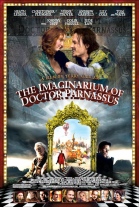The Imaginarium of Doctor Parnassus
|  Although it will probably forever be remembered as the movie Heath Ledger was shooting when he unexpectedly died early last year, The Imaginarium of Doctor Parnassus is first and foremost a Terry Gilliam movie, with all the good and the bad inherent in any creation by the imaginative, but disaster-prone iconoclast. Unfortunately, Doctor Parnassus tends to revel more in Gilliam’s faults than his virtues; although there are resplendent moments in which he takes you places you never quite thought possible, they are mired in the kind of general narrative mishmash that makes you wish Gilliam would get outside his own head a little more and try harder to get inside of ours. Although it will probably forever be remembered as the movie Heath Ledger was shooting when he unexpectedly died early last year, The Imaginarium of Doctor Parnassus is first and foremost a Terry Gilliam movie, with all the good and the bad inherent in any creation by the imaginative, but disaster-prone iconoclast. Unfortunately, Doctor Parnassus tends to revel more in Gilliam’s faults than his virtues; although there are resplendent moments in which he takes you places you never quite thought possible, they are mired in the kind of general narrative mishmash that makes you wish Gilliam would get outside his own head a little more and try harder to get inside of ours.One of the film’s true pleasures, though, is the imaginarium of the title, which is a colossal, ramshackle traveling theater that is pulled through the very modern streets of London by a team of horses and stops at various locations, drops open, and reveals the archaic vaudeville-style show within. The show is staged by Doctor Parnassus (Christopher Plummer), who at first appears to be a drunken old artiste well past his prime, but is in fact a man of great history who represents Gilliam’s take on the dwindling role of imagination in our rush-rush culture. Parnassus, who was a mountain-dwelling monk many lifetimes ago, is embroiled in an ongoing contest with the devil (Tom Waits), a dandy who goes by the name of Mr. Nick, to prove that people are either inherently evil or fundamentally decent. Parnassus is aided by his troupe of performers, which include his soon-to-be-16-year-old kewpie doll daughter Valentina (Lily Cole), a young man named Anton (Andrew Garfield) who pines for her, and an outspoken dwarf named Percy (Verne Troyer). Their numbers are increased with the inclusion of Tony (Heath Ledger), an amnesiac (and perhaps charlatan) they find literally hanging underneath a bridge. Tony’s past is a mystery, as is much of the movie’s plot, which clearly aims to take its place among great fairy tales, but lacks the soul-grabbing simplicity that makes the best of them memorable. The story’s flights of fancy come courtesy of a magic mirror at the back of the imaginarium’s stage, which lead into an expansive netherworld that is shaped and molded by each individual’s personality. When people pass through its tin-foil exterior, either accidentally or on purpose, they are confronted with a world that caters to their desires, but also gives them a choice to become a better person. If they choose the right path, Parnassus can claim their soul; if not, they belong to Mr. Nick. There are other complications, as well, specifically involving Tony’s convoluted past and Valentina’s tenuous future, which is tied to a pact her father made with Mr. Nick many years earlier. Much of this is relayed via crucial flashback sequences that fill in the story’s otherwise enormous gaps, and had Gilliam and cowriter Charles McKeown (who also collaborated with Gilliam on 1985’s Brazil and 1989’s The Adventures of Baron Munchausen) paced the ambiguities better, the film might have been genuinely intriguing. However, they frontload it with so much narrative haziness and murk that, by the time the explanations finally come, it’s hard to care much about them. Of course, when people go to see a Gilliam film, they expect to be dazzled, and The Imaginarium of Doctor Parnassus has plenty of dazzle to spare. Once characters venture past the stage mirror, they are squarely in Gilliam Land, where there are no rules and anything is possible. Ironically, this is part of what made the film’s completion possible, as Ledger’s death happened during a break in production where all that was left to be shot were the fantasy sequences, which allowed Gilliam to devise a gimmick in which characters alter physical form on the other side of the mirror. Hence, Ledger’s character could be played by different actors, in this case Johnny Depp, Jude Law, and Colin Farrell, each of whom physically mimics Ledger’s scraggly goatee and ponytail but illuminates a different dimension of Tony’s character (Depp is quite good playing the romantic smoothie, Law seems wildly out of place embodying Tony’s enchantment with his freedom in the fantasy world, and Farrell is excellent at conjuring up his dark, seedy side and ultimate desperation). It’s a gimmick, to be sure, but a necessary one that works surprisingly well. The loose nature of the narrative gives Gilliam’s boundless imagination plenty of room to roam, and the film’s fantasy sequences certainly have a poetic vivacity that few other filmmakers can manage. However, not to sound like a Luddite, but I would be lying if I didn’t say that the film’s visual pleasure are hampered here by the all-too-easy use of CGI, which undercuts the sublime delights of the physical effects and clever camera tricks that characterized his previous films like Time Bandits (1981), Brazil (1985), and 12 Monkeys (1995). Although animation is an important part of Gilliam’s aesthetic (he was, after all, responsible for Monty Python’s silly animated bits), the glossy cartoonishness of Doctor Parnassus’ digital imagery doesn’t suit him at all. In the end, though, it is Gilliam’s own unrestrained sense of abandon that gets the better of him, sending his film into a Fellini-like spiral of carnivalesque whimsy that works well enough in isolated setpieces, but never achieves the intended heights of mysticism to which he aspires. Copyright ©2010 James Kendrick Thoughts? E-mail James Kendrick All images copyright © Sony Pictures |
Overall Rating: 
 (2)
(2)


